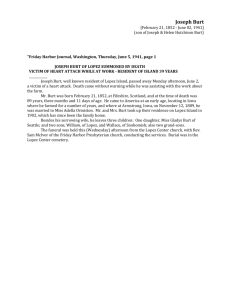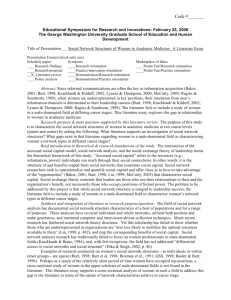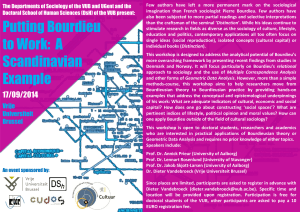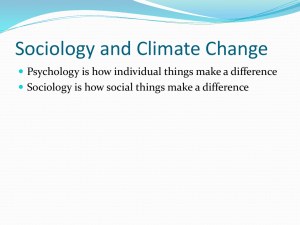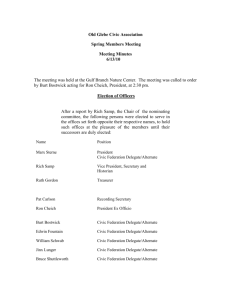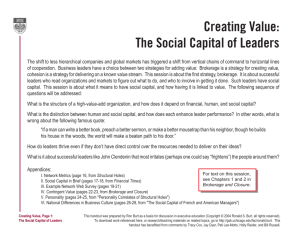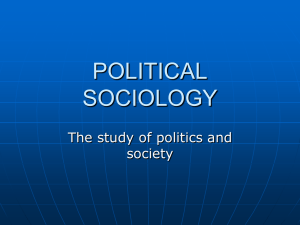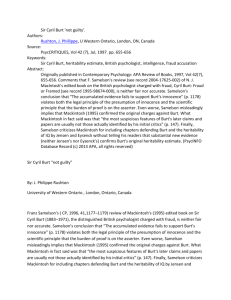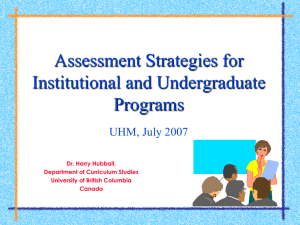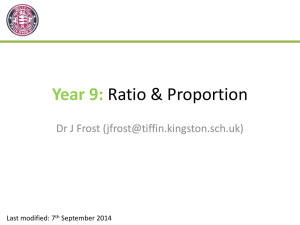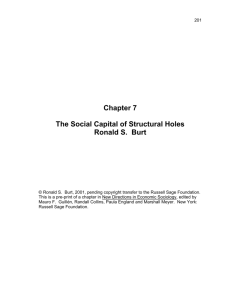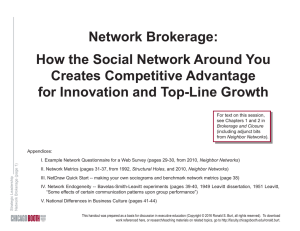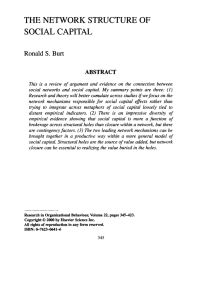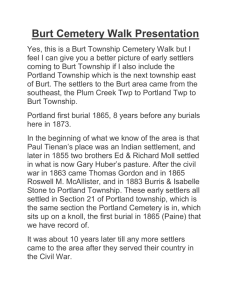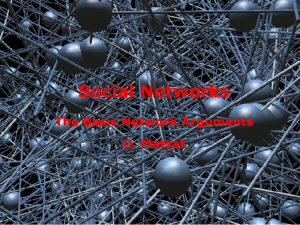Structural Holes - Bureau of Economic and Business Research
advertisement
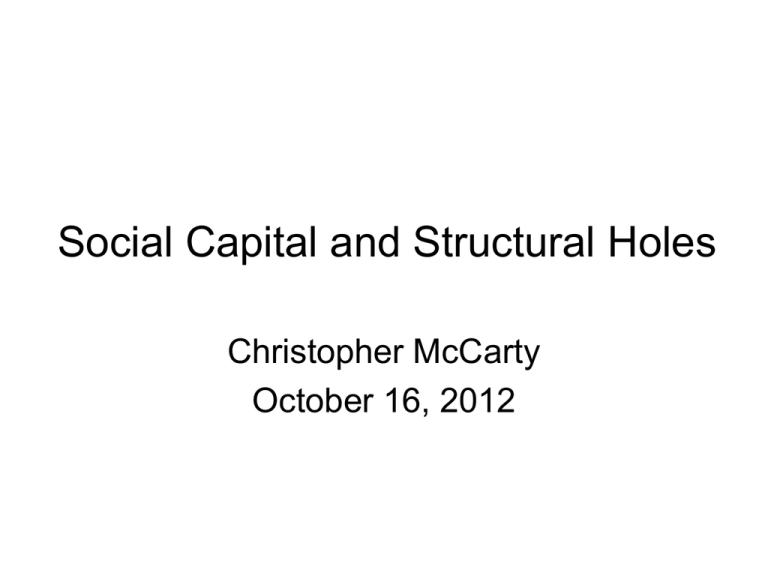
Social Capital and Structural Holes Christopher McCarty October 16, 2012 Alejandro Portes (1998) SOCIAL CAPITAL: Its Origins and Applications in Modern Sociology, Annual Review of Sociology 1998. 24:1–24 • “…the ability of actors to secure benefits by virtue of membership in social networks or other social structures” • “During recent years, the concept of social capital has become one of the most popular exports from sociological theory into everyday language.” • “… the point is approaching at which social capital comes to be applied to so many events and in so many different contexts as to lose any distinct meaning.” Origin of Term ‘Social Capital’ • West Virginia rural educator • Hanifan, L. J. (1916). "The Rural School Community Center". Annals of the American Academy of Political and Social Science (67): 130–138. Origins of concept • Captures ideas of capital from sociology since Durkheim and Marx • What makes it different? – Focus on the positive effects of relations (although there are certainly negatives) – By describing it as capital it opens the door for economic analysis – It represents a non-monetary resource for policymakers How does social capital differ from economic capital? • Both are fungible (can be exchanged) • Social capital exchange is less transparent • Obligations and violations of reciprocity are more difficult to recognize and enforce Pierre Bourdieu • Considered one of the first to clearly articulate the concept • Recognized two parts to social capital – The relationships that provide access to resources – The quality of those relationships • Bourdieu P. 1979. Les trois états du capital culturel. Actes Rech. Sci. Soc. 30:3-6 • Bourdieu P. 1985. The forms of capital. In Handbook of Theory and Research for the Sociology of Education, ed. JG Richardson, pp. 241-58. New York: Greenwood James Coleman • Coleman is responsible for popularizing the concept in American sociology • He saw dense networks as a precondition of social capital • He introduced the concept of closure (cohesion) as a measure of norms which guide the exchange of social capital Sources of social capital • Consummatory (contractual) – Norms for repaying contracts and obeying laws • Instrumental – Accumulation of obligations (social chits) Putnam • Putnam focuses on consumatory: – social capital means “features of social organizations, such as networks, norms, and trust, that facilitate action and cooperation for mutual benefit.” • This is the social capital as measured by the World Bank Potential negative consequences of social capital • Exclusion of outsiders • Excess claims on group members (free-riding from family members) • Restrictions on individual freedoms (current debate about economy and restrictions on financial institutions) • Downward-leveling norms (crabs in a bucket) Social Capital as Security (Focus on Group) • Protection (World Bank and Putnam) • Certainty at the expense of constraint and obligations • Typically at the level of the community • Network closure • High density, cohesion, and redundancy • Leads to protection, cooperation, and sense of belonging but involves obligations and restrictive norms Circularity critique • As a property of communities and nations rather than individuals, social capital is simultaneously a cause and an effect • “if your town is “civic,” it does civic things; if it is “uncivic,” it does not. • “The journey was fast, explaining major social outcomes by relabeling them with a novel term and then employing the same term to formulate sweeping policy prescriptions.” Social Capital as Opportunity (Focus on Individual) • Opportunity (Burt, Lin and Others) • Low density, low redundancy, extensive, complex • Power, influence, • Network brokerage money, advancement, access, advantage, • Leads to control (e.g., etc. information), entrepreneurial opportunities, etc. Network mediated benefit • Stratification leads to: – access to employment (Granovetter) – mobility through occupational ladders (Burt) – entrepreneurial success • Nan Lin’s surveys measure stratification • Both Bourdieu and Burt focus on instrumental social capital, although Burt (and Granovetter) see social capital in less dense ties Closure versus Brokerage Closure • Proponents: Coleman, Putnam, World Bank • Level: Group (typically at the level of the community) • Leads to: Protection, cooperation, and sense of belonging but involves obligations and restrictive norms • Measures: High density, cohesion, and redundancy Brokerage • Proponents: Burt, Lin • Level: Individual • Leads to: Power, influence, money, advancement, access, advantage • Measures: Low density, low redundancy, high betweenness Structural Holes and Good Ideas (Ron Burt, American Journal of Sociology, 2004) • Hypothesis: People who stand near the holes in a social structure are at higher risk of having good ideas • Biochemist Alex Zaffaroni: “He is reading and thinking very widely. He is totally unafraid of any new technology in any area of human creativity. He has wonderful contacts with people in many different areas, so he sees the bridges between otherwise disparate fields.” • Social capital exists where people have an advantage because of their location in a social structure Within a company • Managers are promoted as rewards for having good ideas • Managers with good ideas tend to be brokers within the structure of the company • Good ideas emerge from the intersection of social worlds Structural Holes (Figure 1 from Burt 2004) Network Constraint • Measure of the extent to which the people a respondent knows are tied to each other • High constraint means the network is redundant and recycles information • Low constraint = bridging between groups = good ideas Borgatti’s critique Borgatti, Stehpen P. (1997) Structural Holes: Unpacking Burt’s Redundancy Measures. Connections 20(1):35-38 • Many of Burt’s measures are strongly correlated to existing measures (e.g. network size, degree) • There is a problem comparing Effective Size across networks as the ego networks are of different size • Some of the measures do not do a good job of representing what they are supposed to represent • The concept of structural holes is still sound Four levels of brokerage • Level 1 – • Level 2 – • Transferring best practices from one group to another Level 3 – • Make people on both sides aware of the interests and difficulties in the other Draw analogies between groups ostensibly irrelevant to one another (difficult for people who have spent a long time in a group because they use differences to justify continuing their behavior on the basis that the other group is a different context) Level 4 – Synthesis • A setting dependent on formal chains of command for communication is a setting rich in opportunities to coordinate directly across the formal chains • Age is often negatively associated with new ideas – why? David Krackhardt – The Ties That Torture: Simmellian Tie Analysis in Organizations Additional points • “Structural holes and brokerage can be found in almost any task, depending on point of view.” • “Networks do not act, they are a context for action.” • Ideas may not be desirable Women Gang Data Can you create an environment rich in structural holes? • “This is not creativity born of genius; it is creativity as an import-export business. An idea mundane in one group can be a valuable insight in another.” • ASU experimentation with interdisciplinary degrees and attempts to create new ways of thinking – Old ways of defining departments lead to redundant thinking – Erasing lines allows structural holes to form and new ideas to emerge – Could this happen with old departmental definitions – Are there unpredictable consequences to this? Structural hole analysis of Padgett data • Effective Size – Number of alters minus the average degree of non-ego alters • Constraint – Extent to which ego’s alters tend to be tied to each other • Hierarchy – Extent to which constraint is concentrated in a single alter Structural hole analysis of class data Structural hole analysis of Individual data
